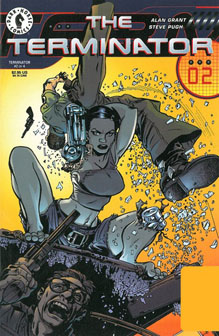Dark Horse’s first entry in its second stint with the “Terminator” license, “Death Valley” (1998) is an entertaining piece of tech-noir heavily caked with the desert dust of a Western.
In this five-issue series (Issue 0, a.k.a. “Special,” followed by Issues 1-4), writer Alan Grant – who would write 13 consecutive “Terminator” issues, tying him with Ron Fortier for the most issues – has a knack for the beats of a “Terminator” yarn. The grizzled VanDirk narrates the events as his hunt for a serial killer turns into a cat-and-mouse game with killer robots.
While Guy Davis’ art on Issue 0 is weak – the naked Terminators look like peach-colored blobs – Steve Pugh follows with entertaining images of increasingly banged-up Terminators in Issues 1-4. Pugh draws the cyborgs’ grim, determined faces particularly well.
The most surprising aspect of “Death Valley” is that – although it’s set in 1998 – it follows directly from the first movie. On this timeline, “T2” and the Malibu Comics did not happen. The events of Dark Horse’s 1984 saga likewise probably did not happen; certainly, Sarah giving birth to Jane (“End Game”) is not part of this timeline. The portrayal of Sarah and John as naïve victims – rather than warriors — gives “Death Valley” the feel of an “Infinities” or “What if?” story.
CHARACTERS
John Connor: The 14-year-old John, having not experienced the events of “T2,” is a good-hearted kid who has been raised well by Sarah, although he’s also naïve and innocent. In this story, Sarah finally tells John about Kyle and his destiny.
Sarah Connor: She’s working as a maid at a roadside motel near Death Valley. Rather than the hardened character of “T2,” this 33-year-old hasn’t changed much from the final scenes of the first movie. She decided to run and hide from Skynet rather than fight it. She calls herself “Sarah Stanton,” a name she assumed “years earlier.”
Kyle Reese: Dead for 14 years, and 12 years from being born.
Killerman: A serial murderer and leader of a devil-worshipping cult, he tells the T-800s he knows the location of Sarah and John Connor. Actually, he knows of Sara and Jon Norden. As the Terminators track Killerman, he opts to use the Norden family as bargaining chips.
The Norden family: A hapless desert-dwelling family who get mistakenly targeted by Terminators due to the mom being named Sara and the kid being named Jon.
Dr. Newbert: An entrepreneurial weapons designer, it seems he’ll be the new father of Skynet. But it turns out his killer robot – which looks like a prototypical HK-Tank — is in this yarn just to put a couple chinks in the Terminators’ armor.
VanDirk: The story’s narrator, this war veteran turned bounty hunter is tracking Killerman at the time the Terminators intervene.
TERMINATORS
D-800.L: A female T-800.
D-810.X: A male T-800 who suffers a malfunction during time displacement. It causes him to develop a sense of wonder and morality. Much to his partner’s bafflement, he looks for ways to avoid killing, if possible.

CONTINUITY
“Death Valley” picks up in 1998, 14 years after the events of the first movie. Sarah and John have lived in Death Valley for five years, and did not experience any of the turmoil of “T2” or “Cybernetic Dawn.” It seems the events of Dark Horse’s 1984 saga are not part of this timeline, either. Clearly, the fact of Sarah giving birth to Jane (“End Game”) is not part of this timeline.
A Terminator in the Future War plays dead (or “employs decoy tactics”), similar to the T-800’s last-ditch strategy against the T-1000 in the steel factory, as described in the “T2” novelization.
Skynet tortures a resistance soldier named Stamford for information on John Connor. A similar scene occurred in “Nuclear Twilight.”
TIME TRAVEL
The two T-800s emerge in the California desert rather than Los Angeles, which suggests they experienced time-spatial slippage. The cyborgs also seem to question the time they’ve emerged in, citing a “possible error in time displacement.” Regardless of Skynet’s targeted year and location, it works out fine because Sarah and John actually are living in the desert during this time.
Going by the theory that each instance of time travel instantly changes the timeline, this might be the timeline that happened before it was overwritten by the new time travelers of “T2.” By the logic of one true timeline, that means “Death Valley” is part of a defunct reality. But by the logic of alternate timelines, this reality is as valid as any other.
Evidence for “fate”:
- As Sarah always feared in the 14 years since the events of the first movie, additional Terminators try to track her down. That sparks her to finally tell the 14-year-old John about his destiny.
- Dr. Newbert’s warrior robot – which looks like an early version of an HK-Tank — seems like it’s a path to Skynet, J-Day and the Future War.
Evidence that “the future is not set”:
- “Death Valley” is set in a timeline where the events of “T2” did not happen, nor did the ending of Dark Horse’s 1984 saga where Sarah gives birth to Jane. Most likely, the entire 1984 saga is not part of the “Death Valley” timeline.
- It’s 1998, but Judgment Day (which happened in 1997 in the history of “T2’s” T-800, and in the history of the “Nuclear Twilight” saga) has not happened. Perhaps J-Day also did not happen in 1997 in the history of “Death Valley’s” T-800s either, since Skynet sent them to 1998, which it knew to be a time before the war. It’s also possible that 1998 was an accidental destination, as the Terminators speak of a “possible error in time displacement.”
- As much as it seems like Dr. Newbert will be the new father of Skynet, that doesn’t turn out to be the case, at least for now.

